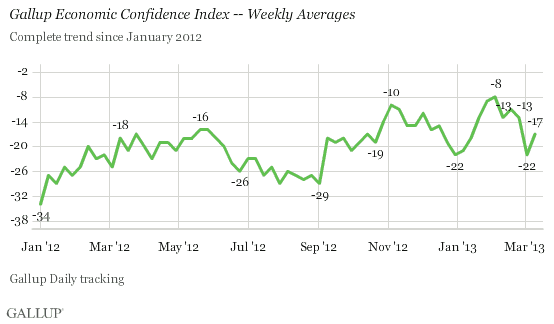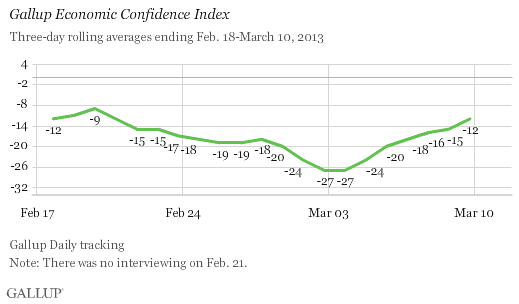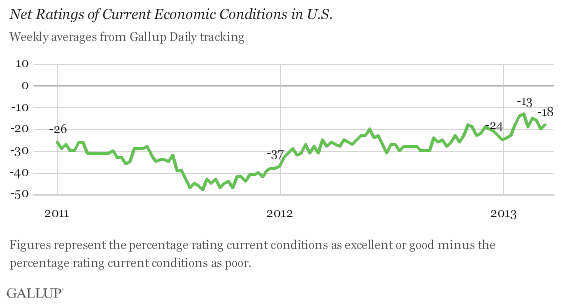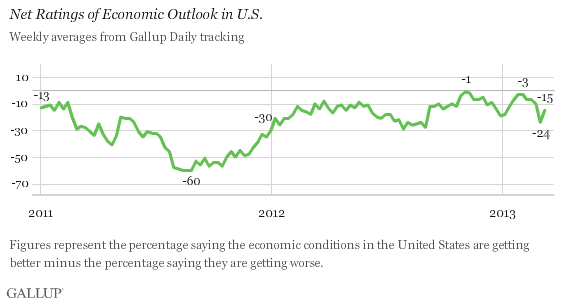WASHINGTON, D.C. -- Americans' confidence in the economy improved last week after it was shaken during the debate in Washington about the budget sequestration. Gallup's Economic Confidence Index improved to -17 from -22 the prior week, when the budget sequestration took effect. Still, last week's score is nine percentage points lower than the five-year high reached in early February.

The Gallup Daily tracking three-day rolling average at the beginning of last week (March 2-4) -- after Congress and the president failed to reach an agreement to avoid the automatic budget cuts -- was -27, tied for the lowest such average since last September. The three-day rolling averages steadily improved throughout the week to -12 for March 8-10. This may have at least partially reflected consumer reaction to last week's gains in the Dow and Standard & Poor's, perceptions that sequestration did not have an immediate impact on many Americans, and Friday's government jobs report that showed unemployment dropping to 7.7%. The three-day rolling averages' steady climb indicates that the jobs report was not the only factor relating to the improvement in economic confidence.

Gallup's Economic Confidence Index is based on Americans' ratings of current economic conditions in the United States as well as their assessments of whether the economy is getting better or worse.
Gallup Daily tracking from last week finds 19% of Americans rating current U.S. economic conditions as excellent or good, while 37% say they are poor. The net score of -18 is lower than weekly net scores from earlier this year, but is still one of the highest scores since the 2008 financial crisis.

Americans' net economic outlook score improved last week to -15 from -24 the prior week. Last week, 40% of Americans said the economy is getting better, while 55% said it is getting worse -- compared with 36% "getting better" and 60% "getting worse" the prior week.

Bottom Line
Americans' economic confidence has begun to bounce back after declining when the budget sequestration went into effect. But the news of the sequester was quickly overshadowed by the record highs on Wall Street last week, and was followed by a positive unemployment report on Friday. The high stock values and positive unemployment report may have signaled to the public that, in the short term, sequestration may not have such a severely negative impact on the U.S. economy.
Still, more Americans are likely to notice the effects of sequestration over time if Congress and the president do not reach a deal, particularly as a deadline looms on March 27, when the continuing resolution to fund the government expires.
Gallup.com reports results from these indexes in daily, weekly, and monthly averages and in Gallup.com stories. Complete trend data are always available to view and export in the following charts:
Daily: Employment, Economic Confidence, Job Creation, Consumer Spending
Weekly: Employment, Economic Confidence, Job Creation, Consumer Spending
Read more about Gallup's economic measures.
View our economic release schedule.
Survey Methods
Results are based on telephone interviews conducted as part of Gallup Daily tracking March 4-10, 2013, with a random sample of 3,563 adults, aged 18 and older, living in all 50 U.S. states and the District of Columbia.
For results based on the total sample of national adults, one can say with 95% confidence that the margin of sampling error is ±2 percentage points.
Interviews are conducted with respondents on landline telephones and cellular phones, with interviews conducted in Spanish for respondents who are primarily Spanish-speaking. Each sample of national adults includes a minimum quota of 50% cellphone respondents and 50% landline respondents, with additional minimum quotas by region. Landline telephone numbers are chosen at random among listed telephone numbers. Cellphones numbers are selected using random digit dial methods. Landline respondents are chosen at random within each household on the basis of which member had the most recent birthday.
Samples are weighted to correct for unequal selection probability, nonresponse, and double coverage of landline and cell users in the two sampling frames. They are also weighted to match the national demographics of gender, age, race, Hispanic ethnicity, education, region, population density, and phone status (cellphone only/landline only/both, cellphone mostly, and having an unlisted landline number). Demographic weighting targets are based on the March 2012 Current Population Survey figures for the aged 18 and older U.S. population. Phone status targets are based on the July-December 2011 National Health Interview Survey. Population density targets are based on the 2010 census. All reported margins of sampling error include the computed design effects for weighting.
In addition to sampling error, question wording and practical difficulties in conducting surveys can introduce error or bias into the findings of public opinion polls.
For more details on Gallup's polling methodology, visit www.gallup.com.
